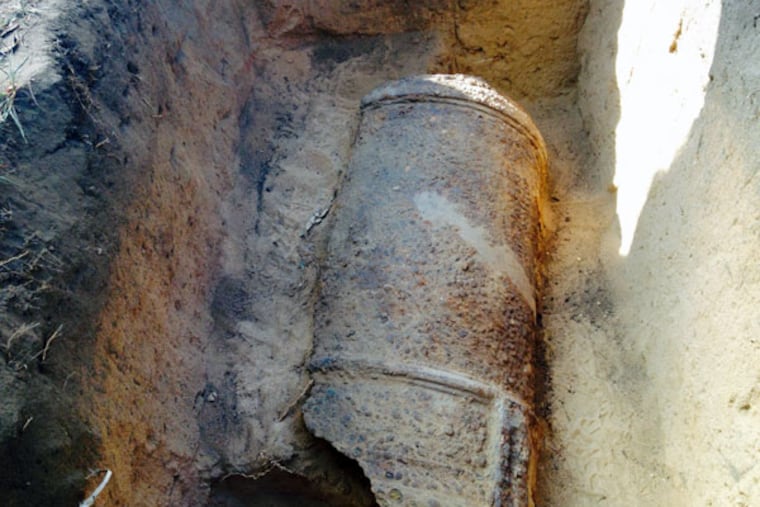Archaeologists find possible historic cannon at Red Bank
Historians who studied the Battle of Red Bank in 1777 have long known the tragic story of an American gun crew.

Historians who studied the Battle of Red Bank in 1777 have long known the tragic story of an American gun crew.
It was one of several defending Fort Mercer against a much larger army of Hessian soldiers, who were trying to dislodge them and open up the Delaware River for British ships to supply the Redcoats occupying Philadelphia.
The crew loaded a massive cannon, lit the fuse, and fired - but the breech exploded, killing a dozen members of Rhode Island regiments who were manning the gun and earthworks.
No one conducting an archaeological investigation of the battlefield in National Park, Gloucester County, expected to find evidence of that deadly moment 238 years ago. Over the past few months, JMA, a West Chester firm in charge of the dig, has recovered the usual refuse of battle: musket balls, shell fragments, buttons, buckles, and ramrods.
But Tuesday, archaeologists unearthed what could be the cannon that blew up during that Oct. 22 fight, when hundreds of Hessians were cut down during a 45-minute hailstorm of iron and lead.
"Everyone was surprised when the ground-penetrating radar picked up a large anomaly about two feet down," said Jennifer Janofsky, curator of the Red Bank Battlefield Park and Whitall House, and Giordano Fellow in Public History at Rowan University.
"Maybe the force of the explosion rocketed it into the earth," she said. "Or maybe it was buried along with other artillery pieces before the Americans retreated."
JMA had been excavating two areas of the battlefield Tuesday when the discovery was made.
The first was checked as "a possible burial spot for Hessian soldiers," Janofsky said. "Based on 18th and 19th century maps, as well as ground-penetrating radar data, JMA opened a 'test unit' to determine if human remains were present.
"While they did find small bone fragments, as well as an 18th century button, it will take a lab analysis to determine if the bones are human," she said. "Given the sandy nature of the soil, the bones were quite soft and difficult to identify."
But the curator believes the remains belong to Hessian soldiers. "If the lab says, 'Yes, it is human' . . . we will mark the spot appropriately," Janofsky said. "If not, it was important to at least look."
The archaeologists could be more definite about the second excavation area.
The ground-penetrating radar "revealed a substantial piece of breached American cannon," Janofsky said. "What is interesting about this find is that we know during the battle, an American cannon experienced a breech failure, killing 12."
"We frequently remember the high number of Hessian casualties, but forget 14 American soldiers died in that battle," she said. "This is a substantial find."
The gun will remain in the ground for now. Another cannon similar to it is on display in the park. The newly discovered gun "is far too heavy to remove," Janofsky said. "We need special equipment - and the cannon will require conservation work."
Fort Mercer, along with Fort Mifflin on the Pennsylvania side of the Delaware River, used cannon fire to prevent British ships from reaching Philadelphia. The Hessians were sent there to eliminate the threat.
About 600 Americans, including many African Americans, manned Fort Mercer, which was commanded by Col. Christopher Greene, a Rhode Islander. The fort had been reconfigured with a French engineer's help to make it more defendable.
It was struck by about 1,200 Hessians, part of a force of 2,300 under Count Emil Kurt von Donop, who told the Americans, "If we storm the fort, there will be no quarter given."
The defenders rejected calls for surrender and, with help from the artillery fire of American vessels in the river, crushed the Hessian attack. Donop was mortally wounded, along with much of his staff.
The discovery of the cannon was further evidence of the battle's violence - and shows the need for more work in the park, Janofsky said.
"It points to how exciting archaeology is and how we need to do more archaeological investigations," she said.